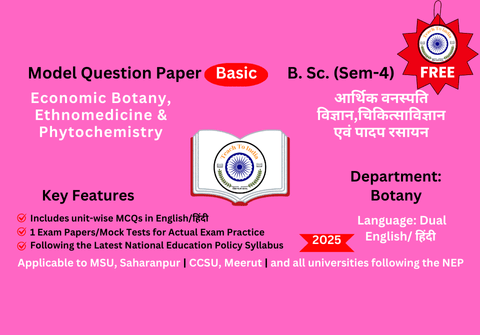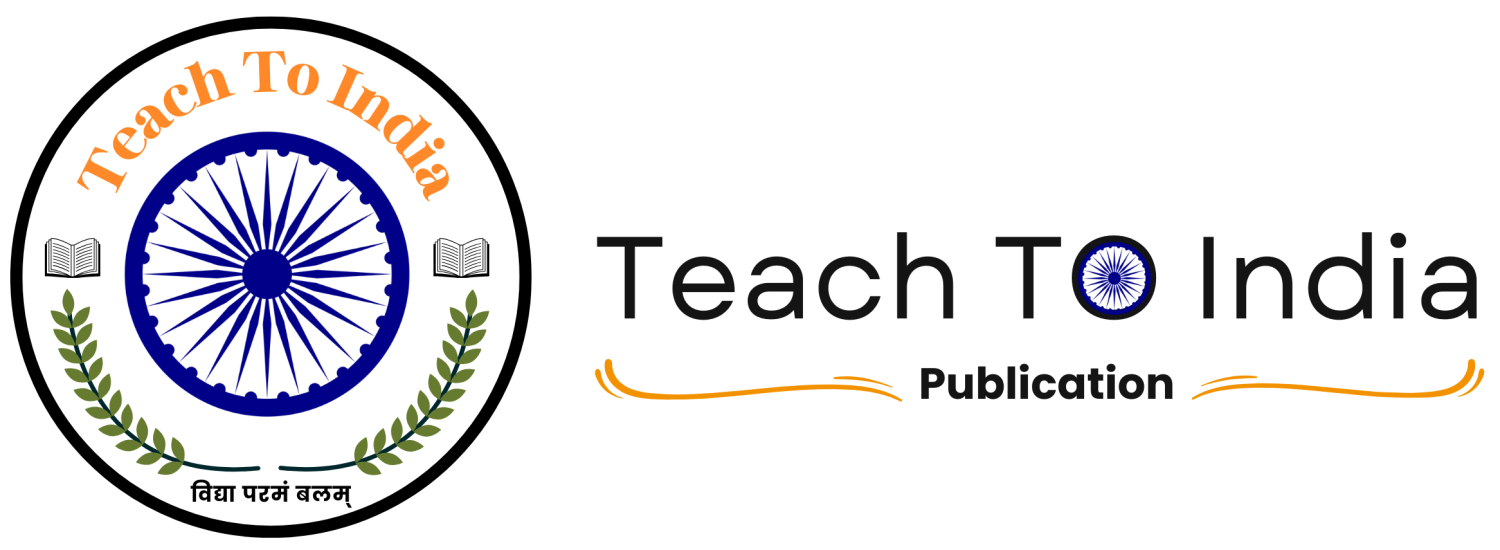Economic Botany, Ethnomedicine & Phytochemistry - आर्थिक वनस्पति विज्ञान,चिकित्साविज्ञान एवं पादप रसायन
- Description
- Curriculum
- Reviews

Model Question Paper
Economic Botany, Ethnomedicine & Phytochemistry – आर्थिक वनस्पति विज्ञान,चिकित्साविज्ञान एवं पादप रसायन
Key Features | मुख्य विशेषताएँ
- Bilingual Model Paper | द्विभाषी मॉडल पेपर
- Enough MCQ for Practice | अभ्यास के लिए पर्याप्त MCQ
- Exam Practice Paper with Mock Tests | मॉक टेस्ट के साथ परीक्षा अभ्यास पत्र
- Latest Syllabus as per NEP | NEP के अनुसार नवीनतम पाठ्यक्रम
- Designed by Experts | विशेषज्ञों द्वारा तैयार किया गया
The given MCQs cover only 10% of the syllabus | दिए गए बहुविकल्पीय प्रश्न केवल 10% पाठ्यक्रम को कवर करते हैं।
To cover 100% of the syllabus with summaries, upgrade to our Advanced Model Paper.| पूरा सिलेबस और सारांश कवर करने के लिए हमारा एडवांस मॉडल पेपर जॉइन करें। Join Advanced Model Paper
|
Program/Class: Diploma in Plant Identification, Utilization & Ethnomedicine/ B.Sc. |
Year: Second |
Semester: Fourth |
||
|
Subject: Botany |
||||
|
Course Title: Economic Botany, Ethnomedicine and Phytochemistry |
||||
|
Course Outcome: After the completion of the course the students will be able to: 1. Understand about the uses of plants –will know one plant-one employment 2. Understand phytochemical analysis related to medicinally important plants and economic products produced by the plants 3. know about the importance of Medicinal plants and its useful parts, economically important plants in our daily life and also about the traditional medicines and herbs, and its relevance in modern times. |
||||
|
Credits: 4 |
Core Compulsory |
|||
|
Max. Marks: 25+75 |
Min. Passing Marks: 33 |
|||
|
Unit |
Topics |
|||
|
I |
Origin and domestication of cultivated plants Centers of diversity of plants, origin of crop plants. Domestication and introduction of crop plants. Concepts of sustainable development; cultivation, production and uses of Cereals, legumes, Spices & beverages.
|
|||
|
II |
Botany of oils, Fibers, timber yielding plants & dyes Study of the plants with Botanical names, Family, part used, and economic uses yielding Edible & essential oils; Sugar, Starch; Fibers; Paper, Fumigatories & Masticatories, Rubber, Dyes, Timber, biofuel crops.
|
|||
|
III |
Commercial production of Flowers, Vegetables, and fruits (To be Chosen area wise) Commercial greenhouse cultivation of rose, Gerbera, Gladiolus, Anthurium/lilium/lily, tomato, bell pepper, cucumber, strawberry & Exotic leafy vegetables using Hydroponics.
|
|||
|
IV |
IPR & Traditional Knowledge IPR and WTO (TRIPS, WIPO), Patent Act 1970 and its amendments, TIFAC, NRDC, Rights, Procedure of obtaining patents, Working of patents, Infringement, Copyrights, Trademarks,Geographical Indications, Traditional Knowledge Digital Library, Protection of Traditional Knowledge & Protection of Plant Varieties and Biotech inventions.
|
|||
|
V |
Ethnobotany Methodologies of ethnobotanical research: Field work, Literature, Herbaria and Musea and other aspects of ethnobotany. Importance of ethnobotany in Indian systems of medicine (Siddha, Ayurveda and Unani), Role of AYUSH, NMPB, CIMAP and CARI.Tribal knowledge towards disease diagnosis, treatment, medicinal plants, plant conservation and cultivation.
|
|||
|
VI |
Medicinal aspects Study of common plants used by tribes (Aegle marmelos, Ficus religiosa, Emblica officinalis, Eclipta alba, Rauvolfia serpentina, Oxalis and Ocimum sanctum) Ethnobotanical aspect ofconservation and management of plant resources, Preservation of primeval forests in the form of sacred groves of individual species and Botanical uses depicted in our epics. Plants in primary health care: common medicinal plants: Tinospora, Acorus, Ocimum, Turmeric and Aloe. Indian Pharmacopeia, Quality Evaluation of crude drugs & adulteration
|
|||
|
VII |
Pharmacognosy Preparation of drugs for commercial market – Organoleptic evaluation of drugs – microscopic evaluation of drugs – Physical evaluation of drugs – Active and inert constituents of drugs -Classification of drug plants – individual drugs – drug adulteration. Sources of crude drugs –roots, rhizome, bulb, corm, leaves, stems, flowers, fruits and seeds; organoleptic study of Adhatoda vasica, Andrographis paniculata, Azedarach indica, Coriandrum sativum, Datura metel, Eclipta alba, Emblica officinalis, Ocimum sanctum,Phyllanthus amarus, Ricinus communis, Catharanthus roseus and Zingiber officinale.
|
|||
|
VIII |
Herbal Preparations & Phytochemistry: Collection of wild herbs – Capsules – compresses – Elixirs – Glycerites – Hydrotherapy or Herbal bath – Herbal oils – Liquid extracts or Tincture – Poultices – Salves – Slippery elm slurry and gruel – Suppositories – Teas. Plant natural products, general detection, extraction and characterization procedures. Glycosides and Flavonoids and therapeutic applications. Anthocyanins and Coumarins and therapeutic applications, Lignans, Terpenes, Volatile oils and Saponins, Carotenoids, Alkaloids and pharmacological activities.
|
|||
-
1Unit 1: MCQs - Economic Botany, Ethnomedicine & Phytochemistry
-
2Unit 2: MCQs - Economic Botany, Ethnomedicine & Phytochemistry
-
3Unit 3: MCQs - Economic Botany, Ethnomedicine & Phytochemistry
-
4Unit 4: MCQs - Economic Botany, Ethnomedicine & Phytochemistry
-
5Unit 5: MCQs - Economic Botany, Ethnomedicine & Phytochemistry
-
6Unit 6: MCQs - Economic Botany, Ethnomedicine & Phytochemistry
-
7Unit 7: MCQs - Economic Botany, Ethnomedicine & Phytochemistry
-
8Unit 8: MCQs - Economic Botany, Ethnomedicine & Phytochemistry







